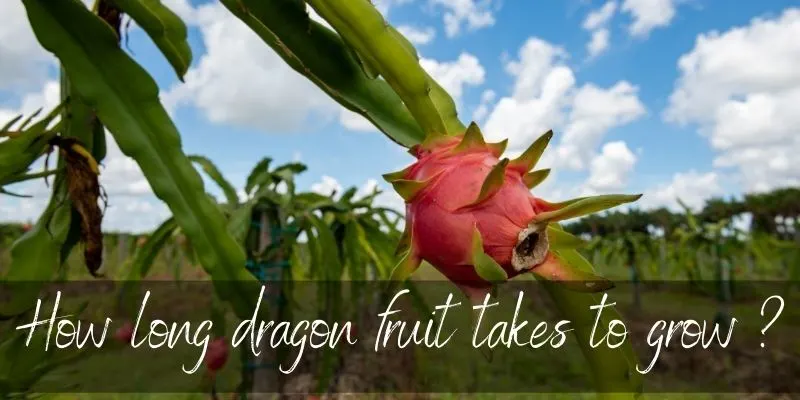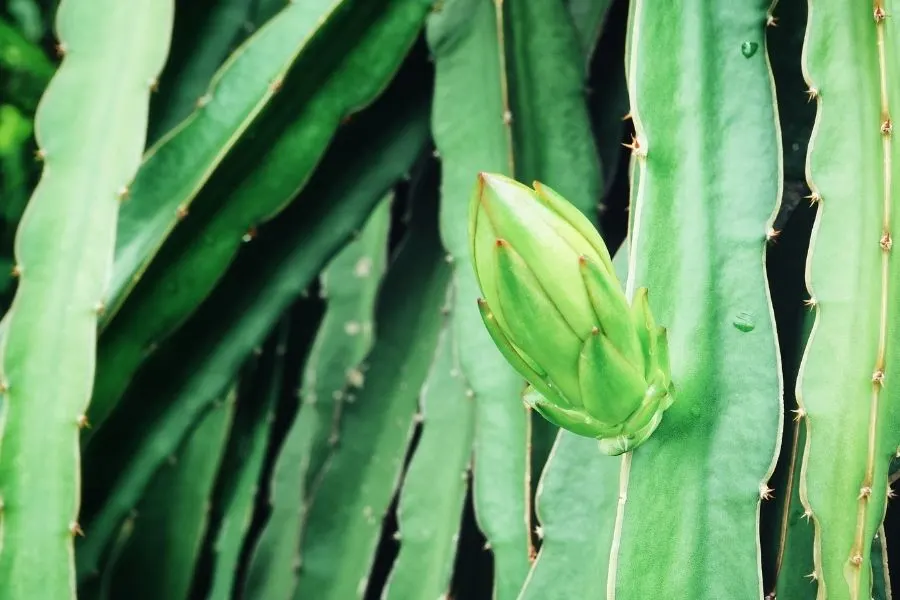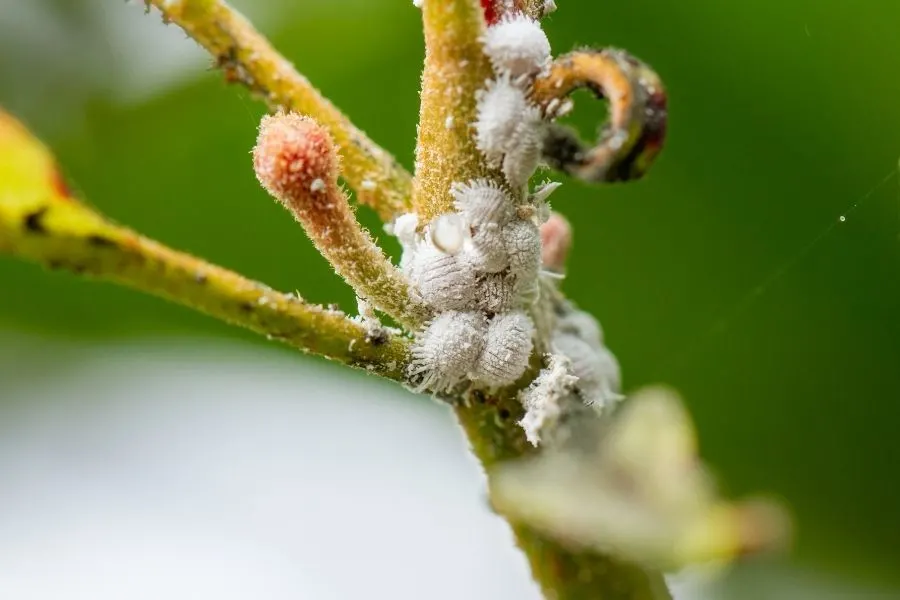Whether bright-yellow, red, or magenta, the dragon fruit’s striking colors are hard to miss at the grocery store.
If you are fascinated by the dragon fruit, also referred to as the pitaya, you should know that the stippled seeds throughout its pulp can be germinated quickly, which means you can grow a full dragon fruit all by yourself.
But how long does it take to grow ?
This is what we’re going to find out today, so stick around.

How long does dragon fruit take to grow ?
Under the right conditions, dragon fruit can germinate in less than two weeks. The plant will then start growing.
The plant will flower after six to eight months, and will bear fruit soon after that.
Keep in mind the vase-grown plants may take up to two years before they start bearing fruit.
Fortunately once this plant is mature, you could realize four to six bearing cycles per year from a plant, which can bear fruit for 20 to 30 years.
Do you want to grow a dragon fruit but don’t know where to start? Read on to find out all you need to know about growing dragon fruit from seed.
Read Also:Here’s All The Dragon Fruit Types Out There
How to Grow a Dragon Fruit at home
Let’s begin with a quick review of this fruit- it is an exotic cactus, native in Mexico, Asia, and some parts of Central and South America.
This fruit can be grown as an ornamental plant, but they’re also great juiced or in smoothies. In fact, they are often used to make ice cream, jams, and some types of wine. All these are more reasons why you should set out to grow dragon fruit.
Dragon Fruit: From Seeds and Cuttings
We already highlighted earlier that you could easily grow the dragon fruit from seeds, but did you know you can also grow it from another pre-existing plant’s cutting?

Pause for a moment before we get on to that. When growing your plant from seeds, all you need to do is slice the fruit and scoop out the seeds.
Separate them from the pulp, wash, then let them dry overnight. You can now proceed to plant the seeds in the soil (use a germinating tray) for them to germinate, after which you can transplant them to a larger pot.
When it comes to growing the dragon fruit from cuttings, ensure you don’t take too much from the parent plant as this can lead to stunted growth.
Also, preferably use this method during warm summer months to achieve optimal results. A cutting which is about one-foot long can produce three or four plants. Proceed to cure and allow the cutting to dry for two to five days; until you notice the tips turn white.
Next, put the cutting around two inches into the soil, ensuring that it’s oriented similarly to how it was on the parent plant. Water it daily. But if the topsoil is not yet dry, you can skip the day.
If everything plays out well, you’ll eventually begin to see some roots develop. New growth is noticeable in around three or four weeks. In some years’ time, the cutting will be ready to bear fruit.
It may not sound like the most lucrative business, and in a way it’s not. It’s actually one of the reasons dragon fruit is so expensive. Still, growing your own will give you a sense of fulfillment.
Keep in mind that if you live in a colder climate your dragon fruit won’t taste as great as those grown it tropical areas.
What the dragon fruit needs to grow
The dragon fruit is a unique type of cactus plant, as it climbs and needs some little support to grow nicely. It’s a tropical plant, hence requires adequate humidity and heat. Let’s breakdown all this plant requires to ensure you nurture this plant until it starts bearing fruit.

• Soil Requirements- The dragon fruit can do well in most well-drained soils. All in all, it prefers growing in slightly acidic soil with a pH level of 6-7. Thus, sandy soils are the best choice, but if it’s not available, only make sure the soil you use is well-drained.
• Fertilizing- To make sure your plant is nurtured correctly, feed it with fertilizer each month during its active growing season. You should avoid fertilizing your plant in cooler regions or cold winters as it becomes somehow dormant-only water the plant, but less frequently.
• Water requirements- The dragon fruit is a cactus plant. So, you should ensure it’s adequately watered. You only water it if the topsoil feels dry when touched. Also, don’t let water sit around because this plant prefers the soil moist, not soaked.
• Light requirements- This plant’s base can do with some little shade, but its tips have to be exposed to sunlight to make sure it blooms nicely. If you give it too much shade, the fruits will not grow as per expectations.
• Temperature requirements- This plant does not do well in colder climates, so ensure that where you plant it, the surrounding temperatures are maintained above 40 degrees. The temperature should be well between 65 to 80 degrees to achieve optimal growth.
Dragon Fruit Pollination
Once this plant starts to flower, you should be in for a treat. The buds will develop for several weeks, then open only for a single night to allow for pollination. The plant’s flowers are enormous and produce a robust and intoxicating smell. Most dragon fruit plant varieties self-pollinate, whereas others rely on moths and bats for pollination.
However some varieties will not self-pollinate, and that’s where hand pollination serves to your advantage. You’ll need a cotton swab to do the cross-pollination effectively. After successful pollination, it’s only a matter of a month before you begin seen fruits grow.
Dragon Fruit Pruning
If left to grow freely, this plant can thrive, up to 20 feet tall. Thus, yearly pruning is essential. Typically, fall is the best time to do the pruning of your full-grown dragon fruit plant.
Ensure you sterilize the pruning shears you’re going to use, then remove all dead or decaying stems or foliage. Also, trim crowded parts to enhance airflow.
Read Also:Does Dragon Fruit Grow On Trees ?
Pests and Diseases that might affect the Dragon Fruit Plant
Aphids and mealybugs can be quite a problem for the dragon fruit. Both are sap-sucking pests, which basically feed on the plant’s tasty sap.

Furthermore, aphids can also attract ants, which will also attack your plant. Other pests that might give you a hard time are thrips and mites. Even though they won’t kill the plant, they can significantly affect its overall health.
One of the most common signs of infections to your plant is the dragon spots, mainly occurring on the plant’s leaves and stems. Bacteria might also cause rotting in the soft stem.
Because the illnesses are transmitted from one plant to the other, sterilization of clippers is essential. Too much water will cause root rot, whereas excessive sunlight might result in sunburns.
In case you realize any of these pests and diseases, reach out to an agrovet for the best pesticides and help with disease-control methods.
That said, the dragon fruit has multiple health benefits, from helping manage various chronic conditions to offering essential nutrients, and many more.
However, it retails at a very high cost in most grocery stores across the US. For these reasons, it’s worth going all through the hassle to grow your own plant.

